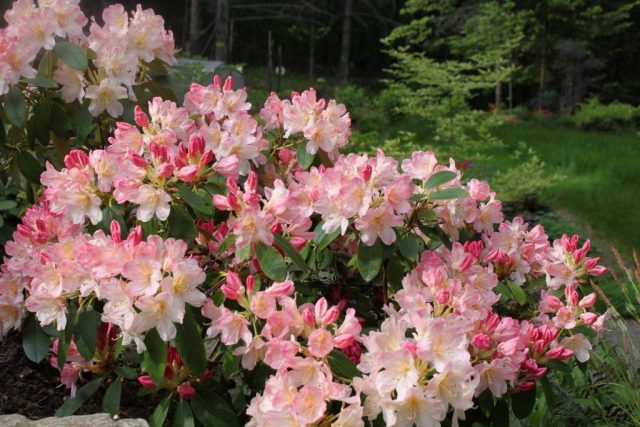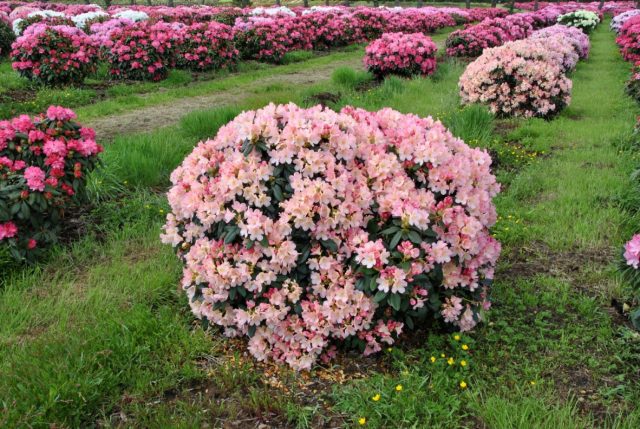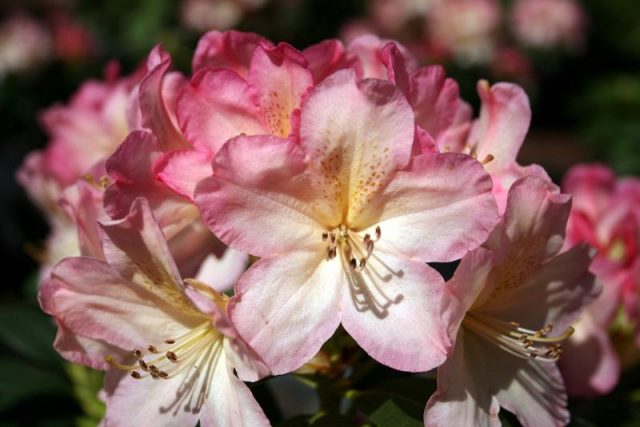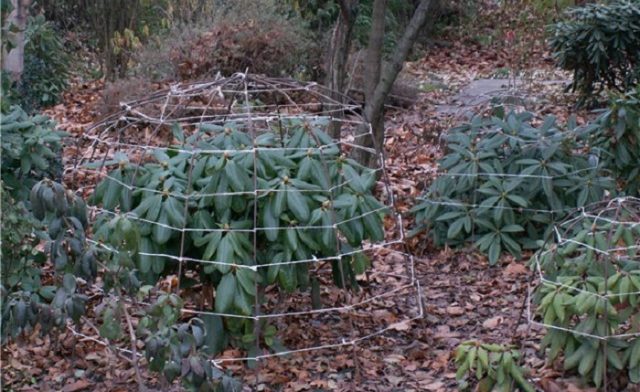Content
Rhododendron Percy Weissman is a beautifully flowering evergreen hybrid created on the basis of the Japanese wild plant. The Yakushiman species in its natural state is widespread in the mountains, winter-hardy and moisture-loving. A feature of the varieties of Japanese rhododendrons is their development in the shade, under the canopy of tall, but not fruit trees.
Description of the Yakushiman rhododendron by Percy Weisman
Compact shrub rhododendron Percy Weissman, as in the photo, only 90-100 cm high.The roots of the plant are superficial, well-branched, located at a depth of 35-40 cm.The root system of the Yakushiman rhododendron variety occupies a large perimeter of the trunk circle, up to 70-80 cm in diameter ... The crown is rounded, spreading, spreads up to 1.3-1.5 m.Over a year, the shoots grow up to 10-14 cm.
Elliptical dark green leaves have a pointed tip. The leaf blade is dense, leathery, glossy on top, 7-8 cm long, 3-3.5 cm wide. In the sun, the leaves of the plant fade. The leaves of the variety live for 3-4 years. Aged leaf blades turn yellow, curl and fall off. This natural process takes place on the lower branches. If the upper leaves begin to wither, the bush may lack moisture, nutrition, or develop diseases.
Funnel-shaped rhododendron flowers - 5 cm in diameter, are collected in scutes. Blooming buds in the amount of 13-15 pieces form lush spherical inflorescences. Unopened corollas are pink, petals are white with different tints of pink at the edges and a yellow-golden tint in the center. Some petals have golden specks. Gradually, as it fades, the pink tone turns into cream. Long light stamens with darker anthers give a special sophistication to the delicate flowers of the Percy Weissman variety.
Winter hardiness of rhododendron Percy Weisman
The Yakushimansky rhododendron attracted breeders with winter hardiness. In natural conditions, the plant is located at an altitude of up to 2 km. Its hybrids are able to withstand long-term frosts down to - 21 ° C, and short-term ones even up to - 29 ° C.
Growing conditions for rhododendron Percy Weisman
The plant has inherited the characteristics of wild plants. For good development, the Percy Wiseman rhododendron hybrid needs:
- acidic, moisture-permeable soil;
- semi-shady area, without direct sunlight, especially in late winter and early spring;
- regular hydration.
Planting and caring for a rhododendron by Percy Weisman
The culture is planted in early spring. Bushes in containers are also moved in summer.
Selection and preparation of the landing site
For the rhododendron, choose a place protected from drafts. The plant is very decorative, so it is worth taking care of a good imported substrate if alkaline soils prevail on the territory. The acidity of the soil is in the range of pH 4.5-5.5. Saplings develop well in the openwork shade of pines and other conifers with a sparse crown.
Seedling preparation
When purchasing a rhododendron, they monitor the good condition of the leaves and branches, they should be free of breaks and scratches. Seedlings in containers are placed in a bucket of water so that the roots come out of the container without damage. It is advised to destroy the earthen lump around the perimeter in order to free all the thin roots. The buds and flowers are removed. An open root system should have many branches.
Landing rules
When placing a Percy Weissman seedling, follow these requirements:
- for a rhododendron, dig a hole with a diameter of at least 70 cm, a depth of 40-50 cm;
- high drainage layer - up to 15-20 cm;
- the substrate is made up of equal parts of peat and sand, 2 parts of garden or forest land, mixing in compost from leaves;
- a seedling is placed in the finished soil, paying attention to the fact that the root collar should be located 3-6 cm above ground level;
- after the first watering, the near-trunk circle is mulched with peat, any coniferous litter from the forest, crushed with pine bark.
Watering and feeding
According to the description, Percy Weissman's rhododendron is a moisture-loving plant, and the bush is provided with regular watering of 10 liters. Seedlings are moistened every other day, adult bushes - after 2-3 days. In dry periods, evening sprinkling is carried out. Particular attention is paid to the bushes after flowering, during the laying of flower buds. The soil must be constantly moistened so that the bush has enough resources to absorb nutrients from the mulch.
Rhododendrons are not fed with humus. It is better to purchase special mineral preparations for acidophiles, including feeding for conifers. Usually, such products contain substances that acidify the soil, which contributes to the comfortable development of rhododendrons. All fertilizers are applied before the end of June or until July 3-5. Granular preparations are scattered along the diameter of the trunk circle directly on the mulch, and then watered abundantly.
Pruning
The undersized Percy Weissman variety is not pruned regularly. In spring and autumn, they carry out sanitary cleaning from damaged branches. Rhododendron bushes tolerate formation, and it is carried out, if necessary, only 3 years after planting.
Preparing for winter
In October or November, depending on the weather, rhododendrons mulch. The mulch used during the summer is not changed, it is gradually overheated and becomes a top dressing for the bush. In the fall, add new sour peat, pine needles, sawdust on top. A layer of mulch with a height of 7-10 cm should cover the soil well to keep the superficial roots of the Percy Wiseman variety from freezing. From above, the bush is covered with a wire pyramid, which serves as a frame for mats made of natural materials, burlap, agrotextile.
The shelter from the rhododendrons is removed with the arrival of warm days. In March, a dense covering material is removed, leaving agrofibre, which will protect the leaves from bright sunlight.
Reproduction
Varietal Percy Weissman rhododendrons are propagated only by layering, cuttings and grafting in order to preserve their characteristics. Semi-lignified branches are cut from the 20th of June. The fragments are 6-10 cm long, with an oblique cut from below, 2-3 leaves on top. They are treated with special stimulants according to the instructions and planted in a moist substrate from a mixture of peat, sand or sawdust. The rooting of evergreen rhododendron occurs in 3-4 months, subject to high humidity and temperatures of 24-26 ° C. 80-85% of cuttings take root. Saplings grow for 2 years.
For layering, the lower branch of the Percy Weissman variety is instilled in, secured with a bracket, the top remains above the ground. Sprouts appear in 1.5-2 months, are characterized by weak roots, require constant moist soil, mulching with layers of moss. It is better to leave new plants in the same place until the next warm season. Growing up is carried out in containers. According to the observations of flower growers, rhododendron seedlings obtained from cuttings develop slowly.
Vaccinations are carried out in special greenhouses, they carefully monitor the maintenance of the required temperature and sufficient air humidity.
Diseases and pests
If all the requirements for planting and caring for the Yakushiman rhododendron Percy Weissman are met, the bush does not suffer from diseases. Taking care of the good development of an ornamental capricious plant, early spring prophylaxis is carried out annually with Fundazol, and in the summer with Fitosporin. Often yellowish spots appear on the leaves of rhododendrons for other reasons:
- suffer from a lack of nutrients such as potassium, iron, magnesium and nitrogen;
- stagnant water has formed at the roots;
- the acid reaction of the soil has shifted to alkaline.
Rhododendrons are fed with iron or magnesium sulfates, potassium nitrate or ammonium. Leaves damage many insects (beetle, miner moth, weevil, bug), as well as spider mites, which are fought with insecticides and acaricides.
Conclusion
Rhododendron Percy Weissman will give abundant and reliable annual flowering if the bush is provided with the necessary conditions for development. Acidic soil, seasonal mulch renewal, constant watering, sun protection are the main requirements in caring for an ornamental plant.














